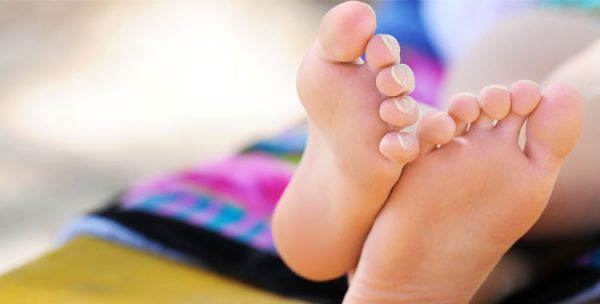Not Just for Walking: Our Revelatory Feet
by BusinessWoman magazine / 0 Comments / 360 View / April 1, 2017
Our feet contain a quarter of the body’s bones. Each foot has multiple joints, tendons, muscles, and ligaments. The nerves and blood vessels in the feet go all the way to the heart, spine, and brain.
So it’s no wonder they’re sometimes a barometer of our general health.
As one example, “If a patient gets cramping in the calves after walking a block or at night while lying flat, that’s often an indication of poor vascular flow,” explained Jennifer L. Mulhern, D.P.M., an associate physician at Martin Foot and Ankle in Lancaster.

Jennifer L. Mulhern, D.P.M., associate physician at Martin Foot and Ankle.
Pain in the calves after short walking distances or while lying flat can indicate that the lower legs are not getting enough blood and nutrients to keep up with the demand.
When a patient presents with these symptoms, a physician needs to rule out blood-flow issues, or what is known as peripheral vascular disease.
“A podiatrist would either order baseline vascular testing to evaluate the blood flow or refer to a vascular surgeon for a further workup,” said Mulhern.
If the patient has cold toes, a lack of hair growth on the feet, or dry skin, a vascular issue may be involved.
Muscle spasms at the end of the day might mean tight muscles, which need to be stretched.
Another condition that affects the feet but is systemic is gout. A gouty attack presents as red, hot, swollen joints, mostly in the big toe. It indicates an elevated uric acid level, leading to the formation of crystals inside a joint.
The podiatrist works with a primary care doctor to treat it and prevent recurrent gout attacks, which can cause arthritic changes in the joint they continue to occur in.
Other types or arthritis can present in the foot: degenerative, post-traumatic (injury), rheumatoid, and psoriatic.
“Although rheumatologic disease affects the joints of the lower extremities, it is often systemic,” said Mulhern.
With psoriatic and rheumatoid arthritis, findings show up on the X-rays of the foot that may be indicative of early signs of a rheumatologic disease. The podiatrist would refer the patient to a rheumatologist for further workup.
Degenerative and post-traumatic arthritis are usually not associated with a systemic issue.
Plantar fasciitis—the inflammation of a thick band of tissue that runs across the bottom of your foot, connecting your heel bone to your toes—causes pain. Inserts or physical therapy, which rehabilitates muscles to improve flexibility and strength and improves symptoms, can help.
“But plantar fasciitis is generally localized,” Mulhern said.
When a diabetic patient comes in, the podiatrist stratifies that person in a specific risk category based on multiple factors and the effects the illness has already had. The stratification identifies the likelihood of the person developing complications in the lower extremities. Diabetes can cause blood flow and nerve problems, and the risk category relates to that.
The longer the glucose is elevated, the more negative effects the person can experience.
A podiatrist who sees patients with “pins and needles in their feet” can rule diabetes in or out with further testing and coordination with a primary care physician. Neuropathy (problems with the nerves, usually the peripheral nerves as opposed to the central nervous system) may also mean the person has diabetes.
In fact, since many people don’t go to a primary care doctor except when they’re sick, it may be the podiatrist who diagnoses the diabetes.
“In the worst-case scenario, a diabetic who has decreased sensation and blood flow may step on something and not realize it,” Mulhern said. “It can open into a wound and potentially become infected, and the patient may have difficulty healing due to decreased blood flow.”
Dehydration can be related to feet—with symptoms of muscle cramping, cracking nails, and dry skin. Poor nutrition leads to poor overall health.
Specifically, nerve symptoms can relate to vitamin B deficiency. Stress fractures (inflammation inside the bone without a precipitating event) can relate to vitamin D deficiency, though this deficiency is sun related, not just diet related.
Numbness in the feet can be a result of many issues. Diabetes is one, but so is entrapment of the nerves called tarsal tunnel (like carpal tunnel in the wrist).
Another problem can be the result of lower-back problems. Patients who have previous lower-back issues or low-back surgery can have lower extremity nerve pain, though “they often don’t put two and two together,” said Mulhern.
Toenail changes can signify systemic issues such as iron deficiency, psoriasis, or liver disease. They can also be related to cardiac disease, but not always.
Fungus is usually localized.
Some people get pitting of nails or clubbing, in which the entire ends of the fingers and nails appear rounded from top to bottom and side to side. This may indicate some cardiac issue.
If experiencing charley horses, you have to increase water or drink electrolyte drinks or tonic water, which contains quinine.
Don’t diagnose yourself.
“A lot of complaints can have multiple pathologies,” said Mulhern. “The physician has to correlate the symptoms with the clinical picture and what the patient says.” BW
At-home foot exercises can help foot flexibility:
• Drawing the alphabet with your foot in the air helps loosen tight muscles.
• Place the front of your foot on a step and let the back of the foot hang off. Hold for 3 seconds. This improves calf flexibility.
• Stand at a countertop, holding on, and lift your heels off the ground. This strengthens foot/ankle muscles.
• Walk or do physical exercise for general and cardiovascular health.


Your Commment
You must be logged in to post a comment.